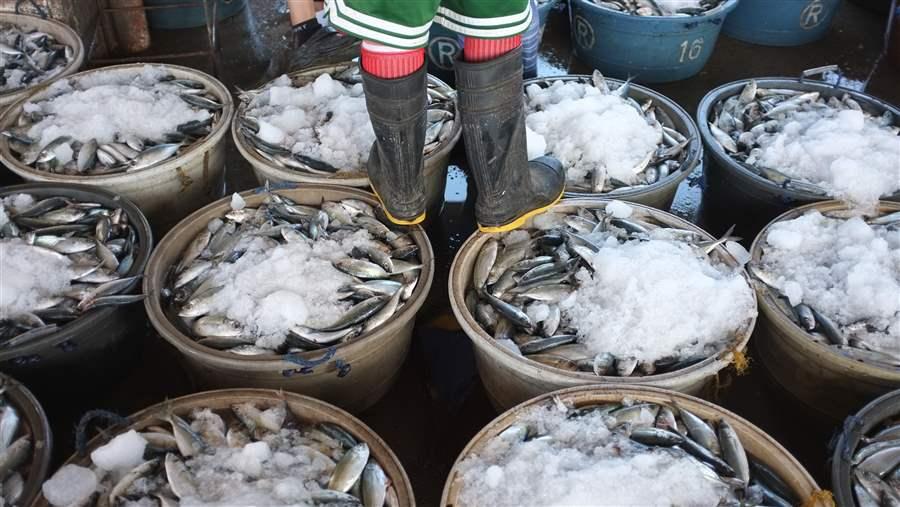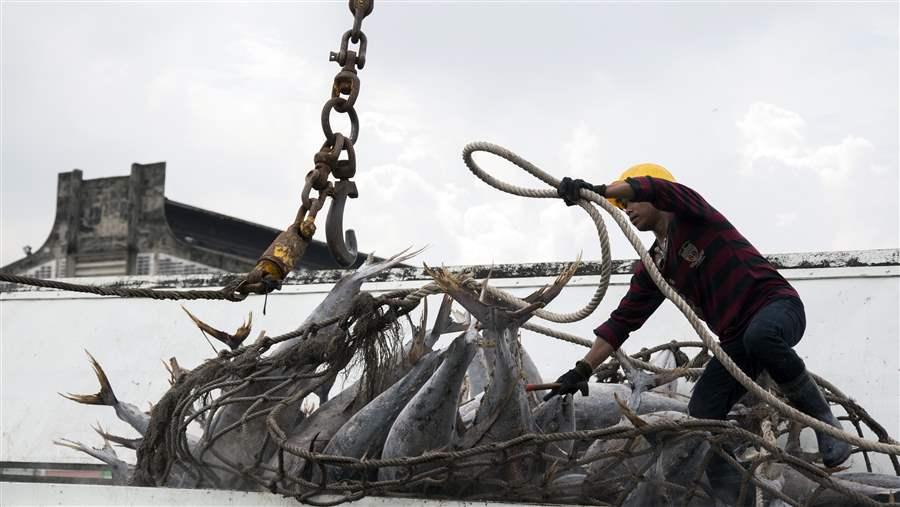Casting a Safety Net on the Seafood Industry
A blueprint for mitigating illegal catch and protecting fishing crews in your seafood supply chain
Overview
Illegal and unreported fishing accounts for up to 26 million metric tons of fish annually worldwide, worth up to $23.5 billion. This equates to more than 771 kilograms (1,700 pounds) of wild-caught fish stolen from the sea every second. With nearly 90 percent of the world’s fisheries either fully exploited or overexploited, it is more critical than ever that steps are taken to address illegal, unreported, and unregulated (IUU) fishing. Illegal fishers cheat coastal communities that depend on healthy fish populations, deceive consumers who trust that the fish they purchase comes through legal supply chains, skew scientific stock assessments that rely on accurate reporting, and undermine law-abiding fishers who play by the rules.
The Pew Charitable Trusts’ ending illegal fishing project conducts outreach to seafood companies on what can be done to help prevent illegally caught fish from entering supply chains. A number of international agreements address fishing on the high seas, and if seafood buyers are held to those standards and work to meet them, supply chains can eliminate IUU fish. Companies can also help ensure safe and decent working conditions throughout the fishing industry. Until the International Labour Organization’s 2007 Work in Fishing Convention1 entered into force in 2017, there was no instrument setting international labor standards for workers employed in the sector. And nearly all global safety regulations pertaining to safety still fail to address worker standards, including the International Convention for the Safety of Life at Sea—meaning that exploitative practices can easily go undetected. By engaging with seafood retailers, processors, and the food service and hospitality sectors, we hope to build consensus among those businesses on how to keep illicit catch off the shelf and improve working conditions for fishers.
What can you do?
You—retailers, processors, and seafood buyers in the food service and hospitality sectors—can reduce the market into which illegal fish can be sold, and through responsible buying policies, improve labor conditions for people working in your seafood supply chains as well.
You can track and trace your supply chain, mapping the links between processors, ports of landing, and fishing vessels to identify business owners and ensure that they are adhering to regulatory guidelines. The following actions can help to keep illegally caught fish from entering your supply chain and protect people working within it.
- Can each vessel be uniquely identified? Without a unique identifier, vessels conducting illicit activity can change name or flag to evade detection. The first step is to require that every vessel 12 meters or more in length2 be issued an International Maritime Organization (IMO) number, a unique and permanent identifier similar to a serial number that stays with the ship from construction to scrapping. IMO numbers are the first point of reference in positively identifying ships and could help curtail illegal fishing and improve safety at sea. You can scrutinize vessels now by ensuring that they are not found on regional fisheries management organization (RFMO) IUU lists, and in the future by looking up their history on the Food and Agriculture Organization’s Global Record of Fishing Vessels.3
- How can I be sure where vessels are operating? With no secure system to monitor and track fishing activity, vessels can operate anywhere around the globe without fear of detection. The second step is to require that all vessels be installed with a vessel monitoring system (VMS) as the primary tracking device, a secure satellite- based transmission system developed for fisheries management and used to report a vessel’s location. All major RFMOs require this of most vessels operating under their regulations, but to ensure that your supply comes from vessels actively using this system, the VMS data should be requested. You can also require that all vessels use automatic identification systems (AIS), which can be used to cross-reference and verify vessel positions. Designed to prevent ships from colliding, vessels that broadcast their location on AIS support greater safety of life at sea.
- How do I know if landings are subject to stringent port controls? Ports known for lax law enforcement or limited inspections are a prime pathway for illegally caught seafood to enter the supply chain. The Port State Measures Agreement (PSMA) requires countries to exert greater controls on foreign-flagged vessels seeking to enter and use their ports. The third step is to work with your suppliers to improve further implementation of the PSMA by checking whether foreign-flagged fishing vessels are using designated ports to land or transship their catch. If they are, consider giving these ports your preference when buying fish. You can also advocate for states to adhere to the PSMA and check how well they are implementing obligatory port controls against IUU fish being landed, particularly during port visits.
- Can I follow the fish from “hook to shore”? Despite the perceived benefits of transshipment for international fishing fleets, gaps in regulatory control and monitoring of this activity at sea create opportunities for misreporting or not reporting catches. This results in the laundering of millions of dollars of illegally caught fish annually, as catch from different vessels is unloaded onto these carrier vessels. The fourth step is to require that all vessels engaged in transshipment at sea have appropriate authorization and are fully monitored, by human or electronic means, or a combination of the two. If this cannot be verified, you can ban transshipment within your supply chain until such time as suppliers are able to prove it is carried out legally and can verify this for you.
- Are people provided safe working conditions? Commercial fishing is one of the most dangerous professions in the world,4 and yet there are no international safety standards for fishing vessels. A lack of oversight throughout the commercial fishing industry means that vessels can operate with few or no safety measures in place. The fifth step is to ensure that all crew and onboard fisheries observers working within your supply chain are able to work in safe labor conditions and that vessels meet the safety standards outlined in the Cape Town Agreement. You can urge flag States to ratify the agreement, helping to bring it into force and raise global safety standards.

Retailers, processors, and seafood buyers in the food service and hospitality sectors can reduce the market into which illegal fish can be sold, and through responsible buying policies, improve labor conditions for people working in seafood supply chains as well.
© John Andrew Uy/EyeEm/Getty Images
Conclusion
You can play a vital role in tackling IUU fishing and improving safety and working conditions on board vessels by examining your supply chain and asking all five questions above. Securing strong oversight of vessel activity is important to protect legitimate industry and prevent illegitimate actors from receiving an unfair advantage.
Implementing policies to require traceability of fish, people, and vessels from catch to landing would minimize the loopholes that some operators use to exploit the oceans and the people who depend upon them.
Endnotes
- International Labour Organization of the United Nations, “Work in Fishing Convention 2007, C188,”http://www.ilo.org/dyn/normlex/en/f?p=NORMLEXPUB:12100:0::NO:12100:P12100_INSTRUMENT_ID:312333:NO.
- International Maritime Organization of the United Nations, “Circular Letter No. 1886/Rev.6,” http://www.iuuwatch.eu/wp-content/uploads/2016/11/FINAL-Circular-Letter-No.-No.1886-Rev.6-Implementation-Of-Resolution-A.107828-IMO-Ship-Identification-Number-Scheme-Secretariat.pdf.
- Food and Agriculture Organization of the United Nations, “Global Record of Fishing Vessels, Refrigerated Transport Vessels and Supply Vessels,” http://www.fao.org/global-record/en/.
- Food and Agriculture Organization of the United Nations, “Safety at Sea as an Integral Part of Fisheries Management” (2001), https:// www.ntsb.gov/news/events/Documents/2010_Fishing_Vessel_Safety_FRM-29-FAO-Pub-966.pdf.







